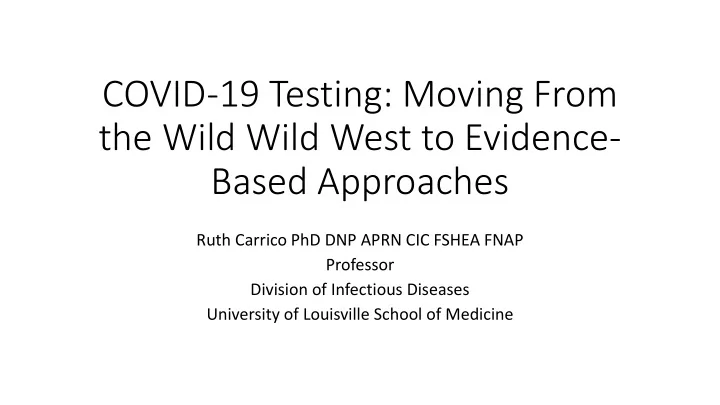

COVID-19 Testing: Moving From the Wild Wild West to Evidence- Based Approaches Ruth Carrico PhD DNP APRN CIC FSHEA FNAP Professor Division of Infectious Diseases University of Louisville School of Medicine
Objectives • Review the current testing landscape involving healthcare • Explore development of a testing strategy that can be individualized
COVID-19 Testing Approaches: Testing for Presence of the Virus • Testing to identify presence of the virus • Nasopharyngeal swab is the gold standard • Performance of testing in a CLIA-certified laboratory is the gold standard • All other approaches will likely provide results that are below this standard • Therefore, if you are testing for diagnosis then gold standard should be the goal • Technique is essential • Right type of swab • Right transport media • Right placement of swab • Right transport conditions
COVID-19 Testing Approaches: Testing for Immunity to the Virus • Testing to identify presence of antibodies • Fingerstick point of care test • Rapid test • Plethora of tests with many yielding inconsistent and inaccurate results • Recently, 20 tests removed from the FDA approval list due to false positive result rates • Phlebotomy • More blood volume and opportunity to concentrate existing antibodies • Better opportunity for accurate results, but many unanswered questions
Testing for Immunity • Testing done via blood draw enables concentration of antibodies and may provide a more valid test to determine presence of antibodies • But, the questions still remain: • Are those antibodies specific to SARS-CoV-2 • Are those antibodies protective • Are there enough protective antibodies to prevent disease • If there are enough protective antibodies to prevent disease, how long do they last • Work continues on those test to improve identification of specific types of protective antibodies and see how they last, including whether or not the individual gets infected again
Testing for Immunity • Typically, during an infection antibodies are produced. • Some immunoglobulins indicate current infection (IgM) • Some immunoglobulins indicate prior infection (IgG) • Some infections result in antibodies that provide long lasting immunity (e.g., rubeola) • Some infections result in antibodies that do not provide any protection (e.g., HIV) • Some viruses change frequently so prior antibodies may be ineffective (e.g., influenza)
Should I Encourage Mass Testing? • NP swab gives you results that represent a single point in time (assuming test done correctly and analysis performed in competent laboratory) • For asymptomatic personnel, testing not recommended unless individual is part of a high risk group (e.g., healthcare worker, long term care resident) • We currently lack sufficient capacity for broad community testing. Therefore, unnecessary testing negative impacts those who need to be tested • If there are special circumstances, local or state public health can assist
I Am Seeking Help With Testing. What Do I Look For in a Test and a Laboratory? • If testing for presence of the virus (you are concerned about illness or asymptomatic carriers), the NP swab is the gold standard. • If you are testing for presence of immunity, please reconsider. Current testing technology using fingerstick testing methods is of limited reliability. CDC, WHO, IDSA encourage use of immunity testing ONLY as a means to determine possible level of prior infection in a community. All discourage use of immunity testing to give individual results without benefit of an expert clinician who can provide context for the results. Larger volumes of blood (e.g., via phlebotomy) have greater likelihood of truer results.
I Am Trying to Develop a Strategy for Testing. What Can I Use as a Roadmap for Success? • First consider the purpose of testing. Then, what will you do with the results? • One approach is to start with the workforce. Engage them in early recognition of illness and empower them to stay home when ill. • Provide mechanism for personnel to access healthcare provider who can assess them signs and symptoms (e.g., Telehealth) • If provider feels testing is indicated, where do they go for testing? • Work-related versus life-related exposure/transmission • Who helps provide context for results, especially if positive, to manage the impact on your facility?
• All personnel provided a digital thermometer and demonstration for use • Email link automatically sent each morning to all personnel • Responses can be entered via cellphone or computer • Request to capture health information relevant for COVID-19 • Responses indicating symptoms of concern will be followed by dialogue box that opens providing instructions (e.g., call designated provider before coming to work) • Response submitted by into REDCap database • HIPAA compliant and secure
Testing Information Ruth Carrico PhD DNP APRN Infectious Diseases CLIA-Certified Reference Laboratory Ruth.Carrico@Louisville.edu PCR testing and clinical relevance Results portal Results generally available within 24 hours of specimen receipt in laboratory
Recommend
More recommend